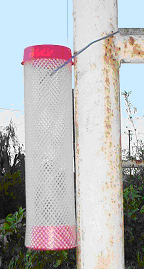|
Fly Parasite Release Station
(FPRS)
Helps you get the most out of your fly parasites.
- Provides protected container for fly parasite wasps to emerge from pupae (they emerge over 3 week period)
- Protects parasites from being trampled or being eaten by birds scratching in manure
- Protects parasites from decomposer activity in manure
- Fly parasites exit through plastic mesh
- Made of tough plastic mesh which resists weather - sheds water
- Low risk of animal injury
- Economical - about $4 each
Fly Parasite Release Stations
Polypropylene, semi-rigid plastic mesh cylinder to safely hold fly parasites for release, can be hung with bail, strapped onto a pipe or hung on a screw. Station protects Fly Parasites from predators, birds, or being trampled under foot, so your fly parasites may continue to emerge over 3 week period. |

|
 |
CODE |
QUANTITY |
PRICE |
FPRS
SET |
set of 5 stations |
18.95 |
5+ sets |
13.00 |
10+ sets |
10.75 |
FPRS
Each |
Individual stations |
6.00 |
The release station can be mounted vertically or horizontally using the enclosed wire, plastic strap or screws (not included) out of the reach of animals.
If using screws or nails for mounting (not included), make a keyhole shaped hole in the side of the release station. Push the head of the screw or nail though the larger opening of the release station and lock in place by pulling down on the release station. Pictured are some suggestions for mounting the Fly Parasite Release Station.

Release station mounted on pipe, using wire bail.
|
|
| Fly Parasite Release Station on post |
Various ways of mounting Fly Parasite Release Stations, bail, zip tie or cable tie, nail, screw. |
Using Release Stations
- Place release stations every 50 to 100 feet or 5-10 per acre, where fly breeding takes place.
- Attach with tape or strap to pole or post, or hang 3 to 5 feet above ground.
- Lift lid, place a tablespoon or two of bulk fly parasites into the container each time shipment arrives.
- When release station is full, empty it and start over.
- If ants find the station, coat the post with a 2 inch band of Stiky Stuff pest barrier above and below the station.
Placement Notes
Release the fly parasites in areas that have these three conditions:
- Decomposing organic matter
- Conditions are constantly moist
- Area remains undisturbed for 7 days
These conditions are commonly found in and around coops, kennels, barns, stables, and stalls, with special attention to hospital and calf pens on dairies, below mangers in horse stalls, around feed bunks on feedlots and around watering areas. Place also around corral posts, fence lines, paddock areas, and other dropping sites, at the edges of manure piles, pits or carts, and wherever manure accumulates. Other potential fly-breeding areas are near (but never directly in) water sources, and near decomposing matter, garbage cans and septic tanks.
Mounting Notes: Hook the bailing wire through a cross beam on a fence post, or on a nail on the wall, and hang the release station vertically. Use the cable strap to bind to posts or fences. Release stations can also be screwed horizontally onto fences, or mounted to walls. Slide the cable tie through the mesh cylinder to strap release stations to posts.
DIY: You can also use cans, flower pots, plastic tubs, or mesh bags to make your own release stations. The release station should shed water, drain water and have holes large for the fly parasites to leave (1/16 inch minimum).
See also
Using Fly Parasites
USDA and EPA Regulatory Issues
|

